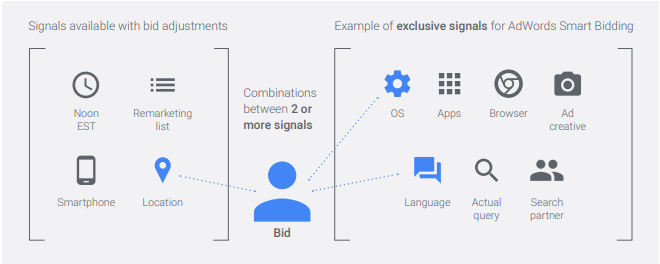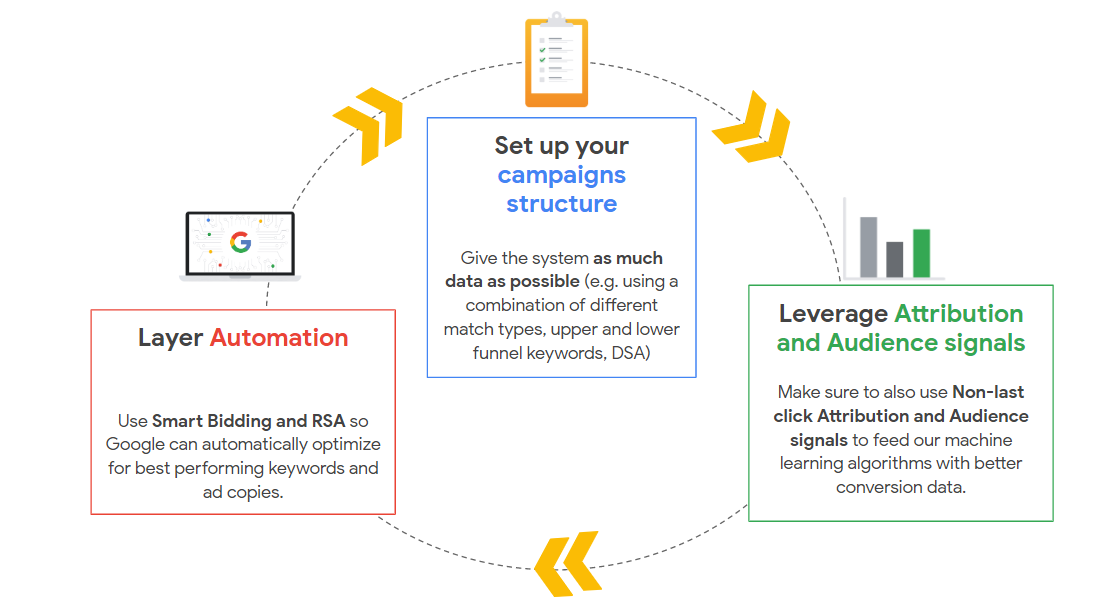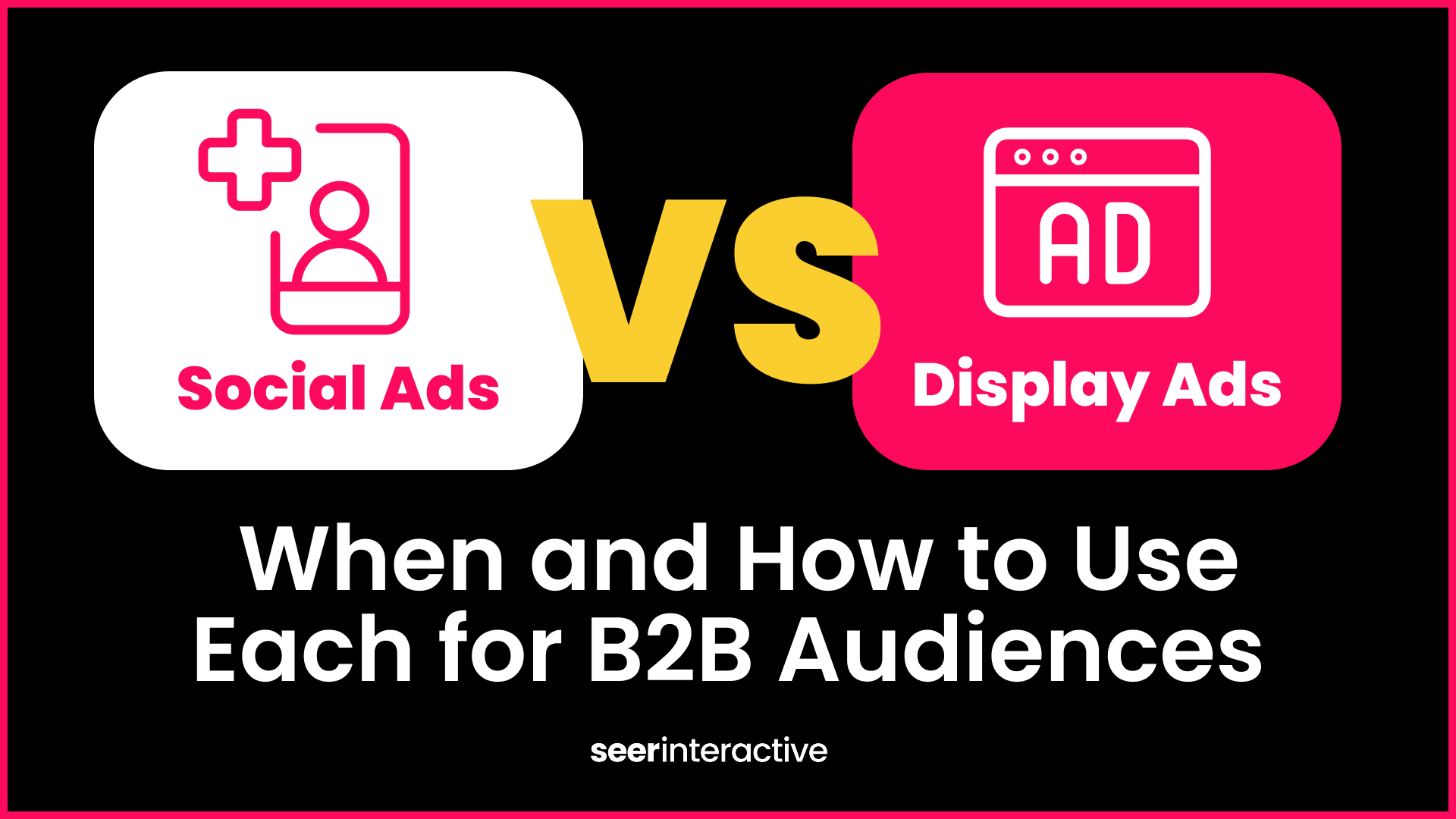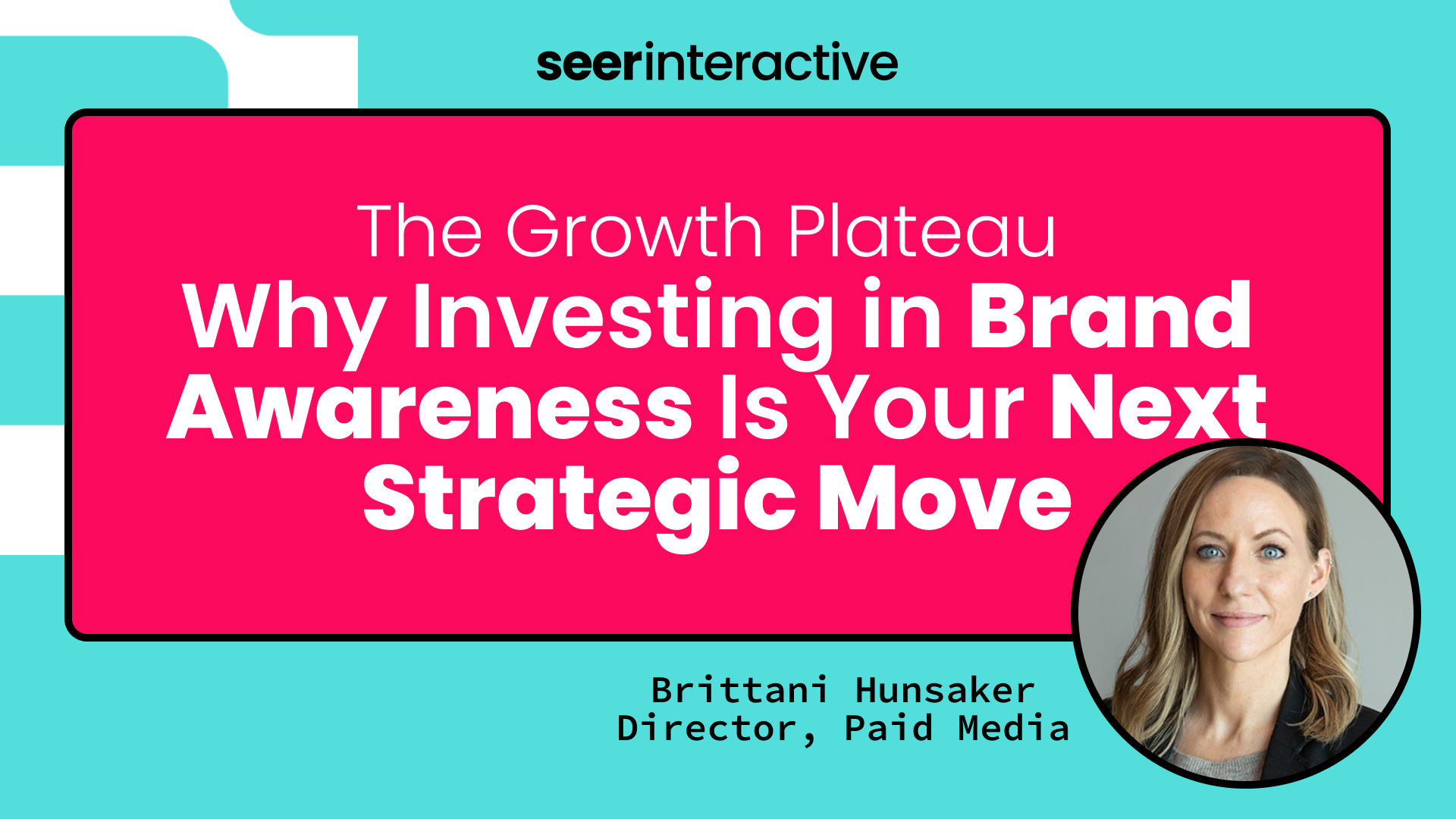Yay, You’ve Picked An Automated Bidding Strategy
And the client is on board to test! But before hitting start on your campaign experiment, ask yourself if your account is structured for success.
Automated bidding strategies are more sophisticated than ever, whether you are managing your campaigns directly from the search engines or using a third-party bid management tool such as Kenshoo.
Benefits of automated bidding include multi-day bid changes, aligning your bid strategy to business objectives and more (read here about why you should be leveraging smart bidding to hit your business goals). Additionally, while the algorithm is determining the right bid based on user intent signals from across the web, account managers have more time to focus on overarching strategy, ad copy, and landing page testing and betas to leverage. All of these enable us to get ahead of the competition and save clients money.

Smart Bidding uses signals combined, per auction. All signals are measured and optimized per auction and query, including thousands of signals exclusive to Smart Bidding (Source: Google)
While these benefits sound great, advertisers should first confirm their accounts are set up in alignment with business objectives to deliver concise results and maximize performance efficiencies for clients.
Doing this legwork before starting will allow managers to continuously test and optimize bid strategies rather than seeing muddled results that might prevent future automated bidding tests from moving forward. At Seer, we always recommend testing into new campaign structures and bidding strategies so we can measure the value of these efforts and return for clients.
To improve machine learning, surpass PPC objectives and have more time for strategic planning, ask yourself the questions below and follow our recommendations for account structure alignment.
Account Structure Considerations
Is targeting (keyword, audience or location) with separate business goals broken out into their own campaigns?
By structuring your campaigns by objectives, you can easily align each campaign with the right bidding strategy to help achieve your goals. Use cases might be:
- Targeting with different purchase intent (brand versus non-brand)
- Varying lifetime value by product/service or higher competition for certain business offerings.
For example, a client has products available for sale on their website where they have revenue-based goals, and they also want to leverage keyword targeting to drive lead form submissions at a target acquisition cost. By breaking the keyword targeting into separate campaigns, you can easily pick the appropriate bid strategies to achieve competing objectives. Remember to keep each bidding test simple and focused on one KPI for more conclusive results.
Not sure what bid strategy to test? Read this blog post on how to leverage Google’s Smart Bidding.
Does my campaign have enough data?
First off, if you do not have conversion tracking set up for your account, set it up before launching smart bidding so the machine has something to learn and optimize off of. If you cannot set up conversion tracking, limit your attention to the Maximize Clicks and Maximize Impression Share strategies where conversions and/or revenue are not a prerequisite.
When testing performance-based smart bidding strategies, more conversion data means greater confidence and faster results. If you are only testing certain campaigns to start, then choose the campaign with the highest volume that you’re comfortable experimenting with. There are also conversion minimums for certain bid strategies, such as Target CPA and Target ROAS, so the algorithm can make bidding decisions to hit your efficiency targets and to decrease the initial learning period.
For example, because of the additional consideration of revenue in the Target ROAS strategy, Google recommends at least 30 conversions in the past 30 days. See the chart from Google below to see how conversion volume can impact both CPA variance and duration of the learning timeframe:

(Source: Google)
When thinking about the data being fed into smart bidding strategies, search managers should use Non-Last Click attribution to assign credit to all touchpoints that occur on the Search Network, and whenever possible use Data-Driven attribution (note, there are minimum data thresholds). The more robust attribution data will help the machine behind the bidding understand the importance of all targeting as it has a more holistic view of a user’s search journey to conversion.
It’s also important to ensure all audiences are layered onto campaigns that Smart Bidding doesn't automatically use (RLSA, Customer Match, Similar) to increase the number of signals that the machine can leverage to determine intent and use for bid optimization. RLSA audiences should be built out based on pages visited and actions taken on-site, but with Smart Bidding, you do not need to segment by list duration.
Are my campaigns limited by budget?
Smart bidding performs best when campaigns are not limited by budget. Limited budgets can prevent ads from showing throughout the day—when there might be better performance—and restrict the amount of data the machine has to learn and optimize from. If the campaign you want to test is limited by budget, consider reallocating shared budgets from other campaigns or pausing underperforming targeting in order to increase budgets to 20-30% higher than daily spend to fully fund campaigns you are testing. Read our blog post here on what to do when your campaign is limited by budget for more tips and tricks.
Account managers should limit the number of changes they make to campaigns once smart bidding has launched since updates to budgets or targeting will impact the learning phase and can cause performance fluctuation.
Thinking through campaign budgets and reallocating in advance of launching a test will streamline the testing time frame and maximize the auction data the algorithm is optimizing bids off of.
Are there campaigns with shared location targeting and budgets that can be consolidated?
If you have an account that is still using the SKAG (single-keyword-ad-group) structure, you should consider simplifying and consolidating your campaigns and ad groups. Due to the advanced machine learning using numerous intent signals (location, time of day, audience, device and more), the algorithm is not focused on match types and is instead focused on user intent. And with the rollout of close variants in 2019 to phrase and broad match modifier keywords, account managers no longer have to build out exhaustive keyword lists to capture every misspelling, plural or synonym variation.
Advertisers should instead focus on simplifying their ad groups by keyword theme to maintain relevance (and quality scores) for ad copy and landing page testing. Match types and same-meaning keywords can be consolidated within an ad group theme to increase the volume of data, which will also improve the speed and confidence of learning for smart bidding strategies. Another added bonus is that ad managers will have more data available at a faster rate for ad and landing page testing results, so that while the algorithm is determining the right bid for the right user we are also serving the right messaging.

Google recommends giving the system as much data as possible when setting up campaign structure (image from Google)
While this may be hard to digest for old school PPC experts, at Seer we too have been using the robust SKAG approach for years as a “best practice” to improve quality scores and to control which search queries ads are shown for. While we are starting to move away from these historical “best practices”, we always test into new account structures and automated bidding so we can determine the value of these efforts and maximize return for clients. Learn more about how we are testing into consolidated account structures.
If you don’t have the hours needed to first complete a consolidated match type and close variant restructure, there are other options available. In both Google Ads Manager and third-party tools such as Kenshoo, account managers are able to group campaigns under a shared portfolio bid strategy (previously referred to as “flexible bid strategies” on Google). Seer recommends this tactic as long as the campaigns have the same business objective.
Are there account expansion opportunities?
If you are in a scenario where you have an excess budget with your current targeting and are worried about becoming ‘too efficient’ with automated bidding, consider testing Dynamic Search Ads (DSA) if not currently utilized. DSA determines which searches to show ads for based on your client’s website, and customizes the ad copy and landing page based on what people are searching for.
With ~15% of daily searches on Google considered new, DSA can help you reach customers that you are not currently reaching only with keyword-based campaigns. Even if you’re not looking to expand current campaign targeting, DSA can help identify new search queries related to your business and related conversion data, to ensure your targeting is evolving as the way users search changes over time. For indexed websites, account managers can create a catch-all DSA campaign to capture any additional traffic your campaigns might be missing and measure incremental results. If you want to keep reporting or budgets consolidated within product or category campaigns, then there is now the option to create a new DSA ad group within your keyword-based campaigns.
DSA and smart bidding strategies are a natural fit because the algorithm is able to match a user’s query to the most relevant site and ad content while also determining the right bid based on their intent. If your client wants to maintain control over ad messaging and landing page destinations, RSAs (Responsive Search Ads) can similarly leverage machine learning to match the right message to the right user at the right bid.
Takeaways
While smart bidding results are exciting—one Seer Max Conversion experiment drove 94.44% more conversions with 17.38% less spend compared to it’s Manual CPC counterpart—before launching headfirst into your automated bid strategy tests, consider your account structure and any optimizations you should make in advance.
Bidding algorithms can only work with the data we’re providing, and advertisers should follow Google’s recommended best practices to maximize performance efficiencies and to set up tests for success.
And remember: automated bidding does not mean set it and forget it. We recommend testing into automated bidding—and to keep testing— to hit and surpass clients’ performance targets.
Think you might need the guidance of a data expert? At Seer, our PPC auditors can evaluate Google’s smart bidding features on your account to make sure you’re getting the most out of every ad dollar. Give us a shout to see if a PPC Efficiency Audit can help you find the best bidding strategy for your account and identify efficiencies to take your account to the next level.


